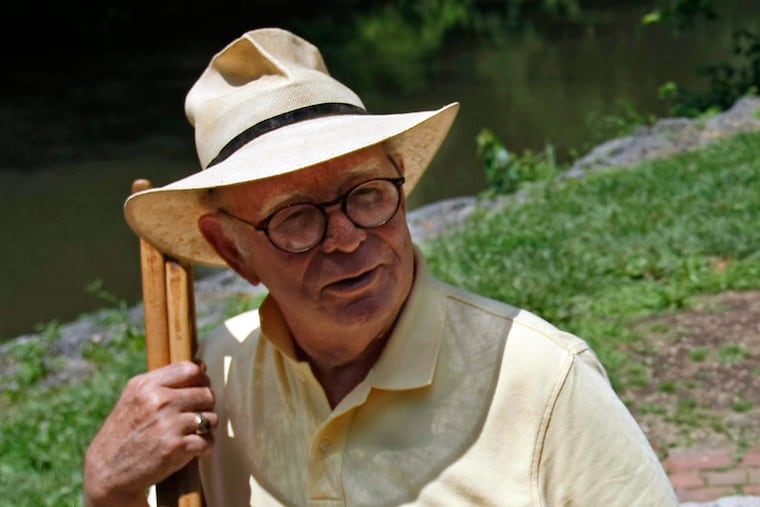George Weymouth, founder of Brandywine Conservancy, museum
George A. "Frolic" Weymouth, 79, a prominent conservationist and artist who founded and chaired the Brandywine Conservancy & Museum of Art, died Sunday morning at his home in Chadds Ford, the conservancy said.

George A. "Frolic" Weymouth, 79, a prominent conservationist and artist who founded and chaired the Brandywine Conservancy & Museum of Art, died Sunday morning at his home in Chadds Ford, the conservancy said.
He had been hospitalized recently for pneumonia, said Andrew Stewart, a spokesman for the organization.
Mr. Weymouth, a member of the du Pont family, was a seminal force in preserving tens of thousands of acres of picturesque scenery around the Brandywine River in Pennsylvania and Delaware. He also was an accomplished painter and combined his passion for nature and the arts by helping to establish the Brandywine Conservancy & River Museum of Art in 1967.
Nearly 50 years later, the organization has protected 62,000 acres, and the museum, which houses 4,000 pieces of art in a renovated grist mill, has become world renowned for its galleries showcasing the work of the Wyeth family, whose members were close friends with Mr. Weymouth.
Jamie Wyeth, Andrew Wyeth's son and himself an acclaimed painter, said in an interview Sunday that Mr. Weymouth was "a Renaissance person" with an uncanny ability to marry his multiple passions - and to get others to care about them nearly as deeply as he did.
"He was one of the most ardent champions of American art and [had] a unique perspective of combining it with the environment," Wyeth said.
Virginia A. Logan, executive director of the Brandywine Conservancy & Museum of Art, said Mr. Weymouth was a convivial and elegant man who inspired nearly everyone around him. "He was one of a kind," she said. "He was just an incredible human being."
George Alexis Weymouth was born in Wilmington on June 2, 1936, to George Weymouth and Dulcinea du Pont Weymouth.
He was given the nickname Frolic in childhood, after his younger brother, Gene, at age 3, lost a foxhound with the same name. The name stuck and came to be an apt fit for a man with a sly sense of humor and insatiable zest for life.
His mother encouraged him at a young age to paint. His other interests included polo and fox hunting. He continued coaching in polo and other horse events throughout his life, at one point serving as chairman of the board of the Brandywine Polo Club.
Mr. Weymouth attended St. Mark's School in Massachusetts, graduating in 1954, and then Yale University, graduating in 1958.
As a teenager, he befriended Andrew Wyeth, who went on to become one of the most beloved American artists of the 20th century. Wyeth was an artistic mentor to Mr. Weymouth, teaching him how to paint in tempera, a fast-drying medium with unique color characteristics. Mr. Weymouth's paintings over six decades came to include landscapes, flower studies, and portraits. Some of his subjects were famous, including Luciano Pavarotti and Prince Philip.
In 1967, Mr. Weymouth, along with two others, bought 47 acres in Chadds Ford that were being threatened by the construction of factories. Land conservation was a relatively novel idea at the time, but Mr. Weymouth was captivated by the Brandywine Valley's beauty and ecological importance.
"Nobody was talking about the environment and conservation in those days," Mr. Weymouth told the Inquirer in 2007. "Ecology was a whole new dirty word."
Four years later, Mr. Weymouth helped acquire Hofmann's Mill, a 19th-century structure along the river, to house an art museum. In particular, he wanted to house the work of the Wyeths. Many of their pieces reflected the lands surrounding the mill that Mr. Weymouth wanted to protect.
Jamie Wyeth said his father was reluctant at first to have a shrine to their work so close to home, but they have come to appreciate the celebration of their work, which is now a popular tourist destination.
"The museum itself combines the art with the environment," Wyeth said. "It's a very proactive museum, not just some little regional museum stuck in the hills."
For everything he accomplished during life, Mr. Weymouth remained an unabashedly unique character. He resided in a stone manor house in Chadds Ford that he illuminated with candles, and he often rode around the property - dubbed Big Bend, due to its location on the river - in a horse-drawn carriage. Passengers included Richard Nixon and Michael Jackson.
Logan, the organization's executive director, said Mr. Weymouth was unfailingly warm and inviting, with an irreverent sense of humor.
In January 2015, for example, he hosted a dinner to honor Jamie Wyeth - but held it in a barn with caged chickens and roosters as centerpieces.
The fowl spontaneously began a call-and-response during Mr. Weymouth's remarks, Logan said, a fittingly playful touch for a decorated and tasteful man who still lived life with a sparkle in his eye.
"You couldn't know Frolic without being impacted," Logan said, "and without being better for it."
Mr. Weymouth is survived by his son, McCoy "Mac" duPont Weymouth; two grandchildren; a brother and a sister; his former wife, Anna Brelsford McCoy; and his companion, Carlton Cropper.
A funeral will be by invitation only. A tribute exhibition will be on display at the museum starting Friday. In lieu of flowers, the family requests contributions to the Frolic Weymouth Endowment Fund of the Brandywine Conservancy & Museum of Art.
215-854-2817@cs_palmer